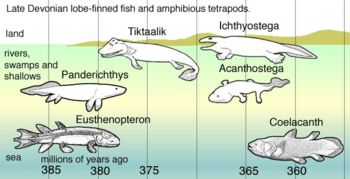
Prehistoric fish are various groups of fishes that lived before recorded history. A few, such as the coelacanth still exist today and are considered living fossils.
The first fish and indeed the first vertebrates, were the ostracoderms, which appeared in the Cambrian Period, about 510 million years ago, and became extinct at the end of the Devonian, about 350 million years ago. Ostracoderms were jawless fishes found mainly in fresh water. They were covered with a bony armor or scales and were often less than 30 cm (1 ft) long. The ostracoderms are placed in the class Agnatha along with the living jawless fishes, the lampreys and hagfishes, which are believed to be descended from the ostracoderms.
The first fish with jaws, the acanthodians, or spiny sharks, appeared in the late Silurian, about 410 million years ago, and became extinct before the end of the Permian, about 250 million years ago. Acanthodians were generally small sharklike fishes varying from toothless filter-feeders to toothed predators. They were once often classified as an order of the class Placodermi, another group of primitive fishes, but recent authorities tend to place the acanthodians in a class by themselves (class Acanthodii) or even within the class of modern bony fishes, the Osteichthyes. It is commonly believed that the acanthodians and the modern bony fishes are related and that either the acanthodians gave rise to the modern bony fishes or that both groups share a common ancestor.
The placoderms, another group of jawed fishes, appeared at the beginning of the Devonian, about 395 million years ago, and became extinct at the end of the Devonian or the beginning of the Mississippian (Carboniferous), about 345 million years ago. Detailed anatomical studies of fossil remains by the Swedish scientist Erik Stensiö strongly suggest that the placoderms were closely related to sharks. Placoderms were typically small, flattened bottom-dwellers, however, many, particularly the arthrodires, were active midwater predators. Dunkleosteus was the largest and most famous of these. The upper jaw was firmly fused to the skull, but there was a hinge joint between the skull and the bony plating of the trunk region. This allowed the upper part of the head to be thrown back, and in arthrodires, this allowed them to take larger bites.
The cartilaginous-skeleton sharks and rays, class Chondrichthyes, which appeared about 370 million years ago in the middle Devonian, are generally believed to be descended from the bony-skeleton placoderms. The cartilaginous skeletons are considered to be a later development.
The modern bony fishes, class Osteichthyes, appeared in the late Silurian or early Devonian, about 395 million years ago. The early forms were freshwater fishes, for no fossil remains of modern bony fishes have been found in marine deposits older than Triassic time, about 230 million years ago. The Osteichthyes may have arisen from the acanthodians. A subclass of the Osteichthyes, the ray-finned fishes (subclass Actinopterygii), became and have remained the dominant group of fishes throughout the world. It was not the ray-finned fishes, however, that led to the evolution of the land vertebrates.
The ancestors of the land vertebrates are found among another group of bony fishes called the Choanichthyes or Sarcopterygii. Choanate fishes are characterized by internal nostrils, fleshy fins called lobe fins, and cosmoid scales. The choanate fishes appeared in the late Silurian or early Devonian, more than 390 million years ago, and possibly arose from the acanthodians. The choanate fishes include a group known as the Crossopterygii, which has one living representative, the coelacanth (Latimeria). During the Devonian Period some crossopterygian fishes of the order (or suborder) Rhipidistia crawled out of the water to become the first tetrapods.
The story of vertebrate evolution started in the seas of the Cambrian period, when jawless, toothless, soft-bodied fishlike creatures wriggled through the water, sucking up microscopic food particles. Only after tough, non-decaying bone was developed (initially as a scaly outer covering and later within the body) did fossils form and become preserved in the rocks. And only then could paleontologists take up the story with any certainty.
The earliest traces of bony scales are found in rocks of the Late Cambrian period, and the first recognizable vertebrate fish has been found in Australian rocks of Early Ordovician age. So, the first chapter in the vertebrate evolution starts with the ancient Arandaspis, a fish about 6in/15cm long with no jaws, no teeth and no fins other than a tail. It did, however, have gills and a stiffening rod of cartilaginous material (the notochord) that served as a backbone.
Groups of various prehistoric fishes include:

Contents |
Jawless fish
- Arandaspis
Astraspis
Boreaspis
Dartmuthia
Doryaspis
Drepanaspis
Errivaspis
Haikouichthys
Hemicyclaspis
Jamoytius
Myllokunmingia
Pharyngolepis
Promissum
Pteraspis
Thelodus
Tremataspis
Cartilaginous fish
- Cladoselache
Cobelodus
Deltoptychius
Heliobatis
Hybodus
Ischyodus
Scapanorhynchus
Sclerorhynchus
Spathobathis
Stethacanthus
Tristychius
Xenacanthus
Sharks, acanthodians and placoderms
- Acanthodes
Bothriolepis
Cladoselache
Climatius
Coccosteus
Ctenurella
Dunkleosteus
Gemuendina
Groenlandaspis
Megalodon or Megatooth shark
Mesacanthus
Ostracoderm
Palaeospondylus
Pterichthyodes
Squalicorax
Primitive ray-finned fish
- Aspidorhynchus
Canobius
Cheirolepis
Dapedium
Lepidotes
Moythomasia
Palaeoniscum
Perleidus
Platysomus
Pycnodus
Saurichthys
Semionotus
Modern ray-finned fish
- Berycopsis
Enchodus
Eobothus
Gryouchus
Gyrosteus
Hypsidoris
Hypsocormus
Knightia
Leptolepis
Pholidophorus
Protobrama
Sphenocephalus
Thrissops
Fleshy-lobed fish
- Chinlia
Dipnorhynchus
Dipterus
Eusthenopteron
Griphognathus
Gyroptychius
Holoptychius
Macropoma
Osteolepsis
Strunius
References
- Janvier, Philippe. Early Vertebrates Oxford, New York: Oxford University Press, 1998. ISBN 0-19-854047-7
- Long, John A. The Rise of Fishes: 500 Million Years of Evolution Baltimore: The John Hopkins University Press, 1996. ISBN 0-8018-5438-5




 216.73.216.190
216.73.216.190 User Stats:
User Stats:
 Today: 0
Today: 0 Yesterday: 0
Yesterday: 0 This Month: 0
This Month: 0 This Year: 0
This Year: 0 Total Users: 117
Total Users: 117 New Members:
New Members:
 216.73.xxx.xxx
216.73.xxx.xxx
 Server Time:
Server Time: